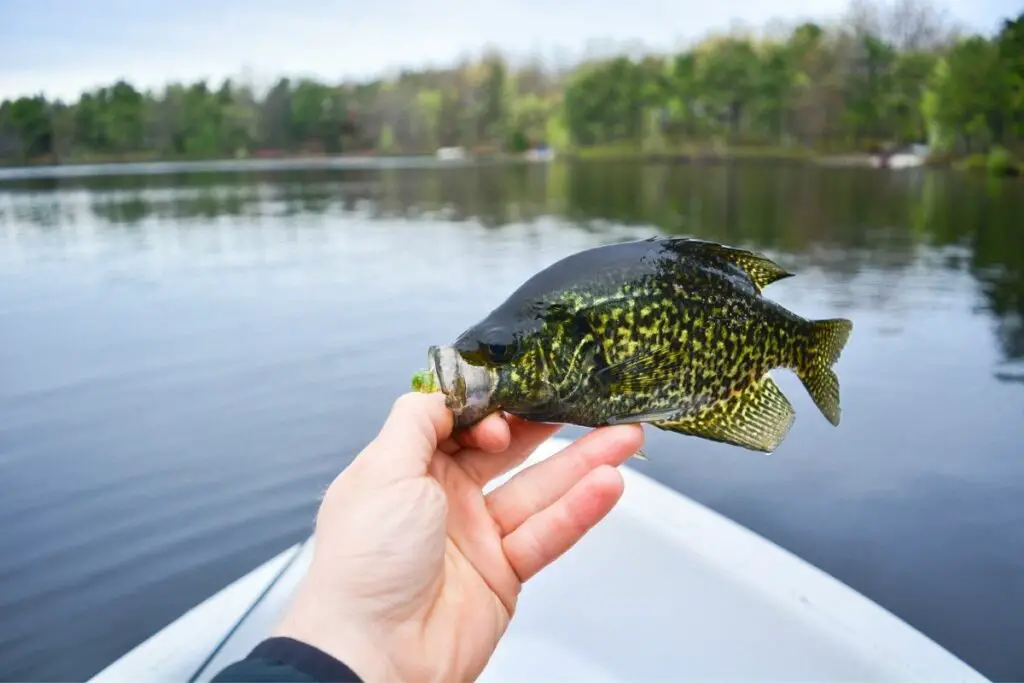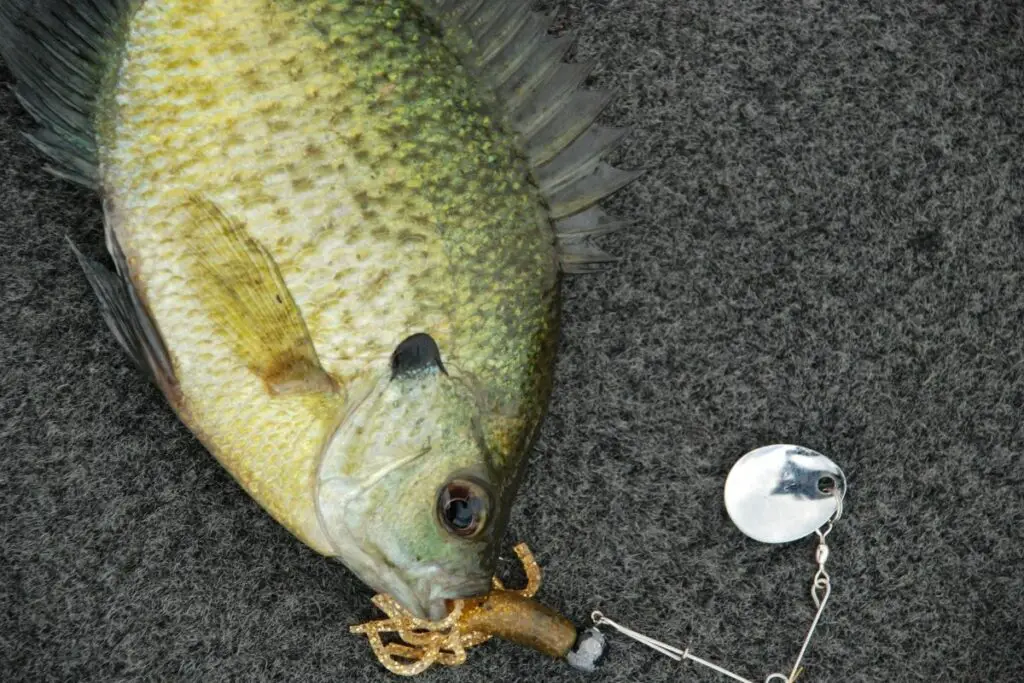
Crappies are the most popular North American freshwater fish from the sunfish family.
They make a tasty dish and can be found across many waters, including streams, lakes, and ponds.
Besides, crappie are available for fishing throughout the year—making them a regular and reliable catch for anglers.
However, to catch crappie, you may need a little statistics on when and where to find them, the right bait and equipment to use, plus the level of experience required.
Although crappie are very elusive and can pose a significant challenge on your fishing line before reeling them in, proper methods and techniques will guarantee you as many crappies as you desire.
Follow along for a detailed guide on how to fish crappie.
Table of Contents
When and Where to Fish For Crappie
Crappie prevalence in most water bodies make them an easy target for anglers.
And while you can fish crappie throughout the year, these fish are seasonally dependent, which is why it’s crucial to figure out their hiding spots as seasons change.
Many anglers consider winter as the most challenging time of the year to catch crappie.
Crappie are less active during such times and will rarely go for your bait or bite anything.
Underwater structures such as rock piles, fallen tree branches, and dock piling are some of the favorite hiding spots for crappie.
Such locations offer good hiding from their prey, such as birds and other prey fish.
Besides, these are good sources of crappie food.
Crappie also spend a considerable amount of time under deep waters, especially when the sun is up and the winds are calm.

They’ll go as deep as 15 feet deep, making them a little harder to find.
Angling in shallow water bodies such as lakes with sand and mud at the bottom will increase your chances of catching more crappie.
Such places have more vegetation that offer them good cover and food.
To heighten your chances for catching more crappie, and avoid much guesswork, find out beforehand if your next crappie fishing location has many fallen tree branches or vegetation.
Crappie also move in clusters, so if you catch one, you can expect to reel in a little more from the same spot, so don’t be in a hurry to move.
Equipment For Fishing Crappie
Packing the right arsenal before setting out for crappie fishing is essential for your success.
Fortunately, crappie fishing does not require expensive equipment such as ones used for big game fishing.
However, your choice of equipment, such as the type of bait and reel, plays a significant role in crappie fishing. Below is what you’ll need.
Bait
Crappies are small-sized fish. Therefore, smaller spinners make the best lures without scaring them away. Small bluegills under two inches are a good option.
For live baits, do not worry about much detail since crappie are easily tempted to pounce on anything that looks like food.
Although insects and worms will attract more crappie, minnows are equally good bait.
Lines
Use a single line when fishing crappie in shallow waters.
Ensure the line is tight enough so that crappie don’t shake themselves off the hook.
Floats
Pencils, wood, and plastics are the best floats for fishing crappie. Just make sure they are as bright as possible.
Reels
Spinning and drum reels tend to be lighter and easier to use.
And since you’re unlikely to reel crappie more than one pound, spinning or drum reels will do the work just fine.
Rods
Graphite or composite graphite are the best rods for crappie fishing.
They are tough and are less likely to break even in harsh conditions.
Jigs
Jigs with furry bodies and feathery tails are ideal for drawing crappie from their hiding spots, especially between reeds and weeds where jigs blend well.

Use pink or white colors since they are highly visible.
To ensure your jigs dangle correctly and are irresistible for the crappie, use a loop knot.
The jigs should be between 1/16 oz and 1/8. Don’t use bigger jigs for crappie.
Crappie Habits You Should Know
Crappie can be highly elusive. To maximize your chances of reeling in more crappie, you’ll need to learn some habits that crappie exude.
Below are some common habits.
- Crappie love hiding under structures such as piers, bushes, jetties, and fallen trees during summer and fall—post-spawn seasons.
- Crappie like feeding early in the morning from around 2 am and at dusk.
- Crappie are mostly out feeding when temperatures are about 55°F. It is the best time to catch them
- Crappie hide deep in the waters for cover when temperatures are freezing. They come out when temperatures rise to about 50°F
Tips and Tricks For Fishing Crappie
Some techniques work better than others for crappie fishing.
For instance, a spinning reel is the best for small fish reeling and may not be suitable compared to retriever reels for big game fishing.
However, to enhance your experience and maximize your crappie catch using any technique, you may need a few tips and tricks.
Below are tips and tricks you can apply.
- Do not hop to the next spot too fast. Crappies move in clusters, and you’re likely going to catch multiple crappie at the same site.
- Crappies are either out in the morning or at dusk to look for food. These are the perfect times you should also go looking for them. If you plan to fish at night, map the location during the day to establish your perfect spots and possible obstacles to avoid.
- Exercise patience during winter as crappies are less active during such seasons and will hardly bite anything, including your bait.
- Fish in clear waters and use bright colors for baits. Crappies use sight to fetch food and may not see dull colors when used as lures.
- For more crappie catch, move your kayak or canoe deep into the waters. You’re less likely to catch crappie at the lakeshores or riverbanks, especially on windy days.
- Network with other anglers around your area on the best crappie spots, best lures, and the best time to catch them. Without the proper knowledge, it’s possible to spend a whole day on the water without a single catch.
- Sometimes crappie will go for a bait that hardly moves. Use a bobber to drift your bait slowly down to the location that may otherwise be inaccessible without one.
- Since fishing rules vary across states, know your fishing limits before setting out to catch any crappie. Such laws may dictate the number of crappie you can take home and the minimum weight you’re allowed to pull from water for food. You can always have your fish scale on board to measure your catch.
Bottom Line
Crappie fishing is one of the fun activities any angler enjoys.
Their prevalence in many water bodies takes out the boredom from the activity—you’ll hardly go home without a catch if you plan well and use the right equipment.
Besides, you can fish for crappie year-round as long as you can study their behavior and master their most active hours, where and at what time to find them.
Also, note that some anglers find crappie more elusive or less active during summer and fall, whereas others report that crappie tend to be more dormant during winter.
Take your time studying their behavior or inquiring from other anglers to get a clear picture before going out crappie fishing.

